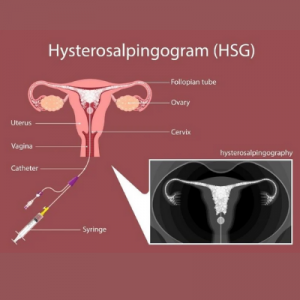HSG (Hysterosalpingogram) is a diagnostic test that is used to evaluate the flow of blood during a menstrual period. It is also used to screen for uterine cancer. The procedure of HSG test is as follows: A dye is injected through the vagina. This dye will show up on an x-ray if there is an obstruction in the Fallopian tubes.
What is HSG?
This test is done to check if the fallopian tubes are open and if the shape of the uterine cavity is normal. This test utilises radio-opaque dye (that is a dye which can be visualised on X-Rays). The dye is instilled inside the uterus and further serial x rays are taken delineating uterus and fallopian tubes.
When is HSG done?
We perform HSG on day 7 through day 11 from LMP to avoid both pregnancy and menstrual bleeding. Additionally, it’s imperative to rule out any uterine or pelvic infection before performing HSG.
Procedure of HSG test
Here is how the HSG procedure is done:
- You lie on your back with your feet placed as for pelvic examination
- Vulvar region and vagina is cleaned with antiseptic solution
- You are draped with sterile sheets
- A vaginal speculum is inserted and local anaesthesia is given over cervix.
- Then cervix is held with an instrument called vulsellum
- Catheter is inserted into the opening of the cervix through the vagina.
- Radio-opaque dye is injected through the catheter
- Serial X-rays are taken demonstrating the dye filling the uterus and entering the tubes, outlining the uterine cavity and length of the tubes. Further, if the fallopian tubes are open the dye spills out into the abdominal cavity

Is HSG Painful?
Yes, HSG can be slightly painful. The painful steps include vaginal manipulation, cervical catch and pain due to distension of uterine cavity with contrast. We try to reduce the procedure related pain by means of pre-procedure analgesics, paracervical block and gradual instillation of dye.
What should I expect after the Procedure of HSG test
After HSG procedure, you can expect to have sticky vaginal discharge as some of the dye drains out of uterus. This may have a bloody tinge. You can use a pad for same. Additionally, you may experience slight vaginal bleeding and cramping abdominal pain.
When should I report to doctor?
Inform your gynecologist/ladies specialist doctor immediately, in case you develop fever, chills, severe or persistent abdominal pain, or foul-smelling vaginal discharge post HSG.

What can be the possible complications of HSG?
Complications with HSG are very uncommon and include infection, allergic reaction and syncope.
In case you are going for HSG and feeling anxious…we have something positive information to share with you!
Pregnancy rates in several studies have been reported to be slightly increased in the first month following a HSG. This could be due to the flushing of the tubes, opening a minor blockage or cleaning out some debris that was preventing the couple from conceiving.

